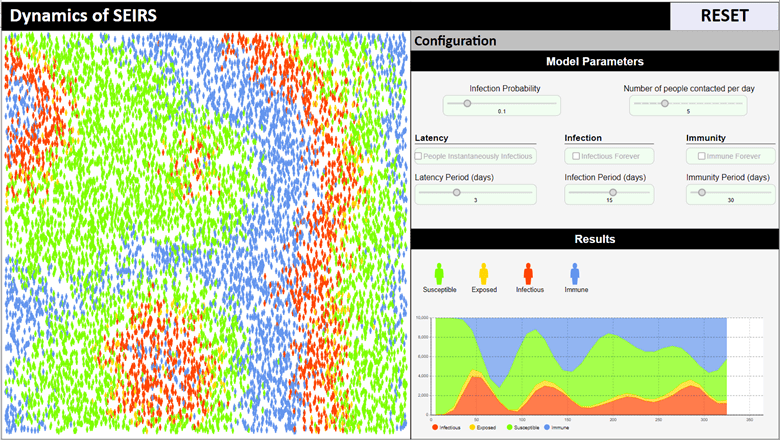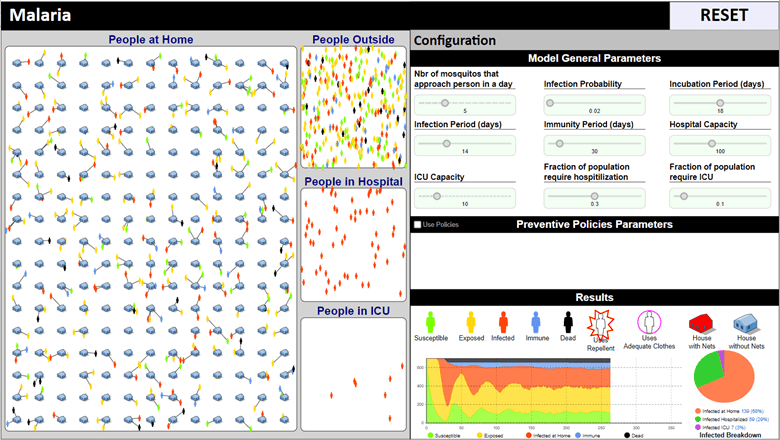
- Client :Raeda
- Category :Agent-Based
- Project Url :
- Date :September 29, 2023
Challenge
This project was part of a research study conducted at the University of Technology and Applied Sciences in Muscat and the University of Sydney. It was found from previous studies that medical students usually face difficulties in grasping certain concepts related to epidemiology. The aim of the study was to build agent-based models that will help undergraduate medical students in understanding systems concepts and in exploring the nature and behavior of various diseases, thus overcoming the difficulties faced with the traditional informative teaching methods.
Solution
Six agent-based models were prepared for students to explore:
- SEIRS model. This model is a typical one used in epidemiology to understand how a new still unknown disease will spread and how long it would take to end. The letters in the name of the model stand for susceptible, exposed, infected, recovered, and susceptible again, respectively.
- Forest fire model: this model shows how a fire spreads through a forest with trees.
- Malaria Model: compared to the Seirs model, this model shows the behavior of a known disease, malaria. Factors such as hospitalization, and disease spread prevention policies (using mosquito repellents and nets) are introduced in this model.
- Marketing Model: This model is used to study the effect of marketing campaigns such as advertisements on the sales of a product.
- Covid-19 Model: This model helps in studying the mode of spread of covid. The model includes sociability factors as well as prevention policies such as using masks, quarantine, and vaccination.
- Predator-prey Model: Predator-prey models are models used to study the dynamics between two or more interacting species in an ecosystem: predators and their prey. These models provide insights into the complex relationship between predator and prey populations and how they can influence each other’s population sizes over time. The species chosen in this model are wolves and sheep.
Although some of these models are not directly related to medicine or diseases, the aim of these models was to convey certain dynamic concepts that are important to understand for medical students. In fact, each couple out of the aforementioned models is meant to convey specific dynamic concepts of systems:
- SEIRS and fire: Emergence https://youtu.be/erc1UpAyc9Q?si=1qHVr-Iwn1nVGTOA
- Malaria and marketing: Tipping point and Resilience https://youtu.be/g5APUbtZXho?si=FqULxZ581xpYKej_
- Covid and predator-prey: Dynamic equilibrium https://youtu.be/B-JusBcULzE?si=IgBzbWwAKe1pzuOS
If you are interested in learning more about these concepts, you can refer to the indicated links above next to each couple from our you-tube channel, and for additional concepts you can refer to the links below.
https://youtu.be/8_HVKkxzhWM?si=3sKGjhxRC8jHz-iM
https://youtu.be/JCqTyUATRZM?si=rZv8xIqlfe2ps5p0
Outcome
These models were used as part of an experiment conducted on students to help in learning complex systems ideas of relevance to understanding epidemics. The study proved that this instructional approach could help students achieve deeper understanding and greater performance on declarative and explanatory knowledge about epidemic diseases as well as transfer of such knowledge for new, not previously exposed to, problems.
Project Features
Industry: Education and Epidemics
Models: Agent-Based
Duration: 1 month






